Optimizing Building Rehabilitation through Nondestructive Evaluation of Fire-Damaged Steel-Fiber-Reinforced Concrete
Abstract
:1. Introduction
2. Experimental Procedure
2.1. Materials and Experimental Setup
2.1.1. Bending Test Setup
2.1.2. Compression Test Setup
2.2. Monitoring Methods and Procedure
2.2.1. AE
2.2.2. Ultrasonic Inspection
3. Results
4. Conclusions
- This study found a significant reduction in maximum load-bearing capacity and UPV values for all fire-damaged specimens compared to intact specimens. This indicates substantial structural degradation due to exposure to fire.
- AE monitoring revealed distinct differences between healthy and fire-damaged specimens. Fire-damaged specimens exhibited higher RA and lower AF values, indicating an increased severity and frequency of internal damage. The variability in AE parameters over time highlighted the progressive nature of the damage.
- A strong correlation between compressive strength and the average amplitude of AE signals was observed, confirming the effectiveness of AE as a diagnostic tool. Similarly, the well-documented relationship between compressive strength and UPV was validated.
- The strong correlations between AE parameters and mechanical properties, as well as between UPV and strength, highlight the effectiveness of these nondestructive evaluation techniques in assessing the structural integrity of fire-damaged SFRC.
- The inferred extensive micro-cracking in fire-damaged specimens, suggested by the gradual rise in AE activity, emphasizes the need for thorough evaluation of internal damage. This interpretation is consistent with established studies using AE data to monitor micro-crack development in fire-affected concrete [49,51,53]. This micro-cracking, which accumulates progressively, contrasts with the abrupt damage observed in healthy specimens and highlights the complexity of assessing fire-damaged SFRC.
5. Recommendations for Future Studies
- Combining time-domain and frequency-domain parameters could lead to a more comprehensive assessment of structural integrity across various concrete structures, enhancing the accuracy and reliability of damage evaluations.
- Utilizing advanced techniques like scanning electron microscopy (SEM) to investigate microstructural changes due to fire exposure could provide deeper insights into the mechanisms underlying AE and UPV behaviors, applicable to a wide range of concrete types.
- Future studies should develop predictive models that integrate AE and UPV data with temperature exposure history to predict the remaining service life of fire-damaged structures, aiding in rehabilitation decisions.
- Research on different types of fiber reinforcements, such as glass or synthetic fibers, could identify the most effective materials for fire-resistant applications and provide insights into how various reinforcements influence residual strength and damage mechanisms.
- Future research should explore the integration of traditional invasive assessment methods with NDE techniques like AE and UPV. Comparative analyses between these approaches could also quantify their respective benefits and limitations, potentially leading to more effective and less damaging assessment strategies for concrete structures.
Author Contributions
Funding
Institutional Review Board Statement
Informed Consent Statement
Data Availability Statement
Conflicts of Interest
References
- Jovanović, B.; Caspeele, R.; Lombaert, G.; Reynders, E.; Van Coile, R. State-of-the-Art Review on the Post-Fire Assessment of Concrete Structures. Struct. Concr. 2023, 24, 5370–5387. [Google Scholar] [CrossRef]
- Ha, T.; Ko, J.; Lee, S.; Kim, S.; Jung, J.; Kim, D.-J. A Case Study on the Rehabilitation of a Fire-Damaged Structure. Appl. Sci. 2016, 6, 126. [Google Scholar] [CrossRef]
- Ghamari, A.; Powęzka, A.; Kytinou, V.K.; Amini, A. An Innovative Fire-Resistant Lightweight Concrete Infill Wall Reinforced with Waste Glass. Buildings 2024, 14, 626. [Google Scholar] [CrossRef]
- Royles, R.; Morley, P.D. Acoustic Emission and Bond Degradation in Reinforced Concrete Due to Elevated Temperatures. Matér. Constr. 1984, 17, 185–191. [Google Scholar] [CrossRef]
- Biradar, G.; Ramanna, N.; Madduru, S.R.C. An In-Depth Examination of Fire-Related Damages in Reinforced Concrete Structures-A Review. J. Build. Pathol. Rehabil. 2024, 9, 81. [Google Scholar] [CrossRef]
- Zapris, A.G.; Kytinou, V.K.; Gribniak, V.; Chalioris, C.E. Novel Approach for Strengthening T-Beams Deficient in Shear with near-Surface Mounted CFRP Ropes in Form of Closed Stirrups. Dev. Built Environ. 2024, 18, 100394. [Google Scholar] [CrossRef]
- RILEM Technical Committee 200-HTC. Recommendation of RILEM TC 200-HTC: Mechanical Concrete Properties at High Temperatures—Modelling and Applications. Mater. Struct. 2007, 40, 855–864. [Google Scholar] [CrossRef]
- Düzgün, O.A.; Küçük, E.N. Post-Fire Seismic Performance of Reinforced Concrete Structures. Structures 2024, 59, 105718. [Google Scholar] [CrossRef]
- Rodrigues, J.P.C.; Laím, L.; Correia, A.M. Behaviour of Fiber Reinforced Concrete Columns in Fire. Compos. Struct. 2010, 92, 1263–1268. [Google Scholar] [CrossRef]
- Amran, M.; Murali, G.; Makul, N.; Kurpińska, M.; Nehdi, M.L. Fire-Induced Spalling of Ultra-High Performance Concrete: A Systematic Critical Review. Constr. Build. Mater. 2023, 373, 130869. [Google Scholar] [CrossRef]
- Heap, M.J.; Lavallée, Y.; Laumann, A.; Hess, K.-U.; Meredith, P.G.; Dingwell, D.B.; Huismann, S.; Weise, F. The Influence of Thermal-Stressing (up to 1000 °C) on the Physical, Mechanical, and Chemical Properties of Siliceous-Aggregate, High-Strength Concrete. Constr. Build. Mater. 2013, 42, 248–265. [Google Scholar] [CrossRef]
- Kalifa, P.; Chéné, G.; Gallé, C. High-Temperature Behaviour of HPC with Polypropylene Fibres: From Spalling to Microstructure. Cem. Concr. Res. 2001, 31, 1487–1499. [Google Scholar] [CrossRef]
- Colombo, M.; Felicetti, R. New NDT Techniques for the Assessment of Fire-Damaged Concrete Structures. Fire Saf. J. 2007, 42, 461–472. [Google Scholar] [CrossRef]
- Poon, C.S.; Shui, Z.H.; Lam, L. Compressive Behavior of Fiber Reinforced High-Performance Concrete Subjected to Elevated Temperatures. Cem. Concr. Res. 2004, 34, 2215–2222. [Google Scholar] [CrossRef]
- Nematzadeh, M.; Nazari, A.; Tayebi, M. Post-Fire Impact Behavior and Durability of Steel Fiber-Reinforced Concrete Containing Blended Cement–Zeolite and Recycled Nylon Granules as Partial Aggregate Replacement. Arch. Civ. Mech. Eng. 2021, 22, 5. [Google Scholar] [CrossRef]
- Xargay, H.; Ripani, M.; Folino, P.; Núñez, N.; Caggiano, A. Acoustic Emission and Damage Evolution in Steel Fiber-Reinforced Concrete Beams under Cyclic Loading. Constr. Build. Mater. 2021, 274, 121831. [Google Scholar] [CrossRef]
- Zhang, T.; Mahdi, M.; Issa, M.; Xu, C.; Ozevin, D. Experimental Study on Monitoring Damage Progression of Basalt-FRP Reinforced Concrete Slabs Using Acoustic Emission and Machine Learning. Sensors 2023, 23, 8356. [Google Scholar] [CrossRef]
- Tonelli, D.; Luchetta, M.; Rossi, F.; Migliorino, P.; Zonta, D. Structural Health Monitoring Based on Acoustic Emissions: Validation on a Prestressed Concrete Bridge Tested to Failure. Sensors 2020, 20, 7272. [Google Scholar] [CrossRef]
- Zhang, P.; Kang, L.; Wang, J.; Guo, J.; Hu, S.; Ling, Y. Mechanical Properties and Explosive Spalling Behavior of Steel-Fiber-Reinforced Concrete Exposed to High Temperature—A Review. Appl. Sci. 2020, 10, 2324. [Google Scholar] [CrossRef]
- Mpalaskas, A.C.; Kytinou, V.; Zapris, A.; Matikas, T. Investigating Fire-Induced Damage on Fiber-Reinforced Concrete Samples Using Nondestructive Evaluation Methods. Proc. Int. Struct. Eng. Constr. 2024, 11, str-31. [Google Scholar] [CrossRef]
- Placidi, L.; Dell’Isola, F.; Kandalaft, A.; Luciano, R.; Majorana, C.; Misra, A. A Granular Micromechanic-Based Model for Ultra High Performance Fiber-Reinforced Concrete (UHP FRC). Int. J. Solids Struct. 2024, 297, 112844. [Google Scholar] [CrossRef]
- Alcaíno, P.; Santa-María, H.; Magna-Verdugo, C.; López, L. Experimental Fast-Assessment of Post-Fire Residual Strength of Reinforced Concrete Frame Buildings Based on Non-Destructive Tests. Constr. Build. Mater. 2020, 234, 117371. [Google Scholar] [CrossRef]
- Kytinou, V.K.; Gribniak, V.; Zapris, A.G.; Chalioris, C.E. An Innovative Health-Monitoring Approach for Fiber-Reinforced Polymer Debonding Diagnosis Through Pullout and Shear Tests. In Analytical and Experimental Methods in Mechanical and Civil Engineering. OES 2023. Structural Integrity; Pavlou, D., Correia, J.A.F.O., Ferradosa, T.F., Gudmestad, O.T., Siriwardane, S.C., Lemu, H., Ersdal, G., Liyanage, J.P., Hansen, V., Minde, M.W., et al., Eds.; Springer: Cham, Switzerland, 2024; Volume 28. [Google Scholar] [CrossRef]
- Chernov, A.V.; Savvas, I.K.; Alexandrov, A.A.; Kartashov, O.O.; Polyanichenko, D.S.; Butakova, M.A.; Soldatov, A.V. Integrated Video and Acoustic Emission Data Fusion for Intelligent Decision Making in Material Surface Inspection System. Sensors 2022, 22, 8554. [Google Scholar] [CrossRef] [PubMed]
- Fedele, R.; Scaioni, M.; Barazzetti, L.; Rosati, G.; Biolzi, L. Delamination Tests on CFRP-Reinforced Masonry Pillars: Optical Monitoring and Mechanical Modeling. Cem. Concr. Compos. 2014, 45, 243–254. [Google Scholar] [CrossRef]
- Mpalaskas, A.C.; Matikas, T.E.; Van Hemelrijck, D.; Liopoulos, S.I.; Papakitsos, G.S.; Aggelis, D.G. Acoustic Signatures of Different Damage Modes in Plain and Repaired Granite Specimens. In Proceedings of the Smart Materials and Nondestructive Evaluation for Energy Systems 2015, San Diego, CA, USA, 9–10 March 2015; Volume 9439, p. 94390L. [Google Scholar] [CrossRef]
- McCann, D.M.; Forde, M.C. Review of NDT Methods in the Assessment of Concrete and Masonry Structures. NDT E Int. 2001, 34, 71–84. [Google Scholar] [CrossRef]
- Kim, Y.-S.; Ohmiya, Y.; Kanematsu, M.; Kim, G.-Y. Effect of Aggregate on Residual Mechanical Properties of Heated Ultra-High-Strength Concrete. Mater. Struct. 2016, 49, 3847–3859. [Google Scholar] [CrossRef]
- Ohtsu, M.; Shiotani, T.; Shigeishi, M.; Kamada, T.; Yuyama, S.; Watanabe, T.; Suzuki, T.; van Mier, J.G.M.; Vogel, T.; Grosse, C.; et al. Recommendation of RILEM TC 212-ACD: Acoustic Emission and Related NDE Techniques for Crack Detection and Damage Evaluation in Concrete. Mater. Struct. 2010, 43, 1187–1189. [Google Scholar] [CrossRef]
- Aggelis, D.G. Classification of Cracking Mode in Concrete by Acoustic Emission Parameters. Mech. Res. Commun. 2011, 38, 153–157. [Google Scholar] [CrossRef]
- Ren, H.; Li, T.; Ning, J.; Song, S. Analysis of Damage Characteristics of Steel Fiber-Reinforced Concrete Based on Acoustic Emission. Eng. Fail. Anal. 2023, 148, 107166. [Google Scholar] [CrossRef]
- Chai, M.; Hou, X.; Zhang, Z.; Duan, Q. Identification and Prediction of Fatigue Crack Growth under Different Stress Ratios Using Acoustic Emission Data. Int. J. Fatigue 2022, 160, 106860. [Google Scholar] [CrossRef]
- Zhang, F.; Yang, Y.; Fennis, S.A.A.M.; Hendriks, M.A.N. Developing a New Acoustic Emission Source Classification Criterion for Concrete Structures Based on Signal Parameters. Constr. Build. Mater. 2022, 318, 126163. [Google Scholar] [CrossRef]
- Scerrato, D.; Giorgio, I.; Della Corte, A.; Madeo, A.; Dowling, N.E.; Darve, F. Towards the Design of an Enriched Concrete with Enhanced Dissipation Performances. Cem. Concr. Res. 2016, 84, 48–61. [Google Scholar] [CrossRef]
- Poon, C.-S.; Azhar, S.; Anson, M.; Wong, Y.-L. Strength and Durability Recovery of Fire-Damaged Concrete after Post-Fire-Curing. Cem. Concr. Res. 2001, 31, 1307–1318. [Google Scholar] [CrossRef]
- Hanaa, F.; Houssam, T.; Kristopher, P.; Albert, N. Lightweight Self-Consolidating Concrete Exposed to Elevated Temperatures. J. Mater. Civ. Eng. 2015, 27, 04015039. [Google Scholar] [CrossRef]
- Xiao, J.; Falkner, H. On Residual Strength of High-Performance Concrete with and without Polypropylene Fibres at Elevated Temperatures. Fire Saf. J. 2006, 41, 115–121. [Google Scholar] [CrossRef]
- Correia, J.R.; Marques, A.M.; Pereira, C.M.C.; de Brito, J. Fire Reaction Properties of Concrete Made with Recycled Rubber Aggregate. Fire Mater. 2012, 36, 139–152. [Google Scholar] [CrossRef]
- Morley, P.D.; Royles, R. The Influence of High Temperature on the Bond in Reinforced Concrete. Fire Saf. J. 1980, 2, 243–255. [Google Scholar] [CrossRef]
- Gorzelańczyk, T.; Schabowicz, K.; Szymków, M. Application of the Acoustic Emission Method and Artificial Neural Networks to Assess the Damaging Effect of High Temperature on the Structure of Fibre-Cement Boards. Materials 2022, 15, 6460. [Google Scholar] [CrossRef]
- Sara, C.; Luigi, B. Assessment of Thermal Damage in Hybrid Fiber-Reinforced Concrete. J. Mater. Civ. Eng. 2010, 22, 836–845. [Google Scholar] [CrossRef]
- Abraham, O.; Dérobert, X. Non-Destructive Testing of Fired Tunnel Walls: The Mont-Blanc Tunnel Case Study. NDT E Int. 2003, 36, 411–418. [Google Scholar] [CrossRef]
- do Nascimento Moura, M.A.; Leal, C.E.F.; Moreno, A.L.; dos Santos Ferreira, G.C.; Parsekian, G.A. Post-Fire Prediction of Residual Compressive Strength of Mortars Using Ultrasonic Testing. Constr. Build. Mater. 2024, 416, 135273. [Google Scholar] [CrossRef]
- Masse, S.; Vetter, G.; Boch, P. Non-Destructive Ultrasonic Evaluation of Thermal Damage in Cementitious Materials. Key Eng. Mater. 2001, 206–213, 1907–1912. [Google Scholar] [CrossRef]
- Chaix, J.-F.; Garnier, V.; Corneloup, G. Concrete Damage Evolution Analysis by Backscattered Ultrasonic Waves. NDT E Int. 2003, 36, 461–469. [Google Scholar] [CrossRef]
- Yim, H.J.; Kim, J.H.; Park, S.-J.; Kwak, H.-G. Characterization of Thermally Damaged Concrete Using a Nonlinear Ultrasonic Method. Cem. Concr. Res. 2012, 42, 1438–1446. [Google Scholar] [CrossRef]
- Chaix, J.-F.; Garnier, V.; Corneloup, G. Ultrasonic Wave Propagation in Heterogeneous Solid Media: Theoretical Analysis and Experimental Validation. Ultrasonics 2006, 44, 200–210. [Google Scholar] [CrossRef]
- Payan, C.; Garnier, V.; Moysan, J.; Johnson, P.A. Applying Nonlinear Resonant Ultrasound Spectroscopy to Improving Thermal Damage Assessment in Concrete. J. Acoust. Soc. Am. 2007, 121, EL125–EL130. [Google Scholar] [CrossRef] [PubMed]
- Adamczak-Bugno, A.; Lipiec, S.; Koteš, P.; Bahleda, F.; Adamczak, J. Detection of Destructive Processes and Assessment of Deformations in PP-Modified Concrete in an Air-Dry State and Exposed to Fire Temperatures Using the Acoustic Emission Method, Numerical Analysis and Digital Image Correlation. Polymers 2024, 16, 1161. [Google Scholar] [CrossRef]
- Grosshandler, W.; Jackson, M. Acoustic Emission of Structural Materials Exposed to Open Flames. Fire Saf. J. 1994, 22, 209–228. [Google Scholar] [CrossRef]
- Grosse, C.; Ožbolt, J.; Richter, R.; Periıki, G. Acoustic Emission Analysis And Thermo-Hygro-Mechanical Model For Concrete Exposed To Fire. J. Acoust. Emiss. 2010, 28, 188–203. [Google Scholar]
- Nguyen, T.-K.; Ahmad, Z.; Kim, J.-M. A Scheme with Acoustic Emission Hit Removal for the Remaining Useful Life Prediction of Concrete Structures. Sensors 2021, 21, 7761. [Google Scholar] [CrossRef]
- Mpalaskas, A.C.; Matikas, T.E.; and Aggelis, D.G. Acoustic Emission of Fire Damaged Fiber Reinforced Concrete. In Proceedings of the SPIE 9806, Smart Materials and Nondestructive Evaluation for Energy Systems 2016, Las Vegas, NV, USA, 1 April 2016. [Google Scholar] [CrossRef]
- EN 12390-5; Testing Hardened Concrete—Part 5: Flexural Strength of Test Specimens. European Committee for Standardization: Brussels, Belgium, 2000.
- Felicetti, R. The Drilling Resistance Test for the Assessment of Fire Damaged Concrete. Cem. Concr. Compos. 2006, 28, 321–329. [Google Scholar] [CrossRef]
- Iwaki, K.; Hirama, A.; Mitani, K.; Kaise, S.; Nakagawa, K. A Quality Control Method for Shotcrete Strength by Pneumatic Pin Penetration Test. NDT E Int. 2001, 34, 395–402. [Google Scholar] [CrossRef]
- Tsangouri, E.; Aggelis, D.G. A Review of Acoustic Emission as Indicator of Reinforcement Effectiveness in Concrete and Cementitious Composites. Constr. Build. Mater. 2019, 224, 198–205. [Google Scholar] [CrossRef]

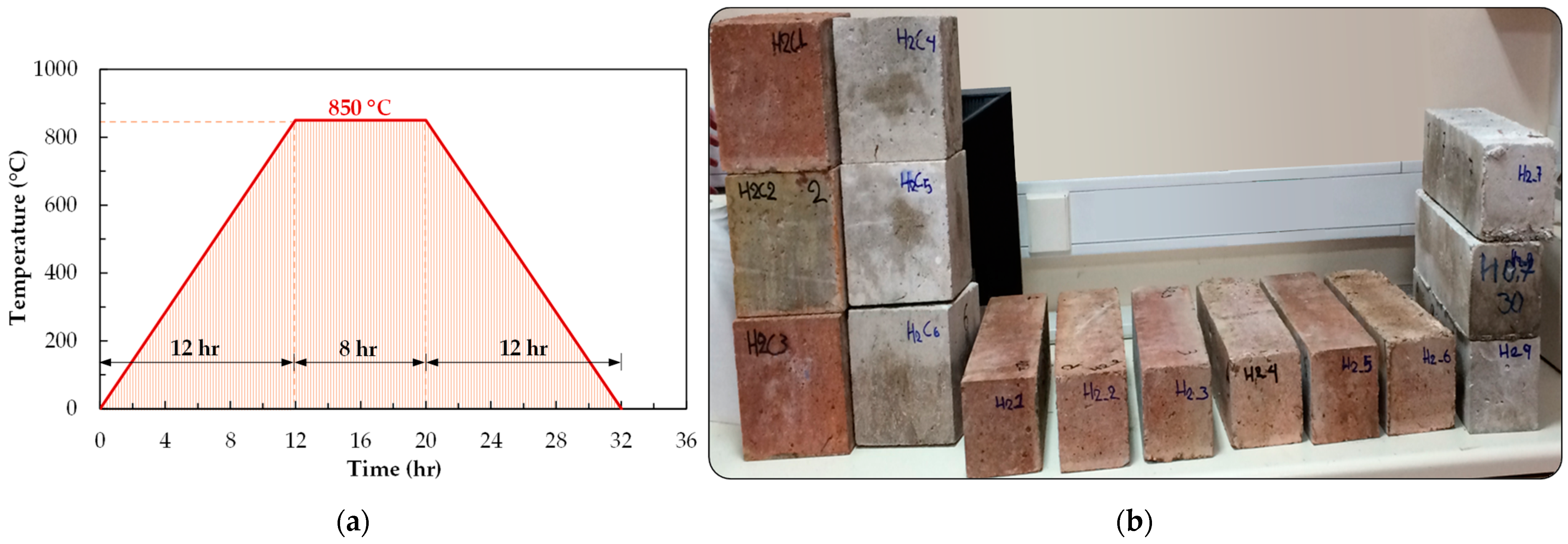



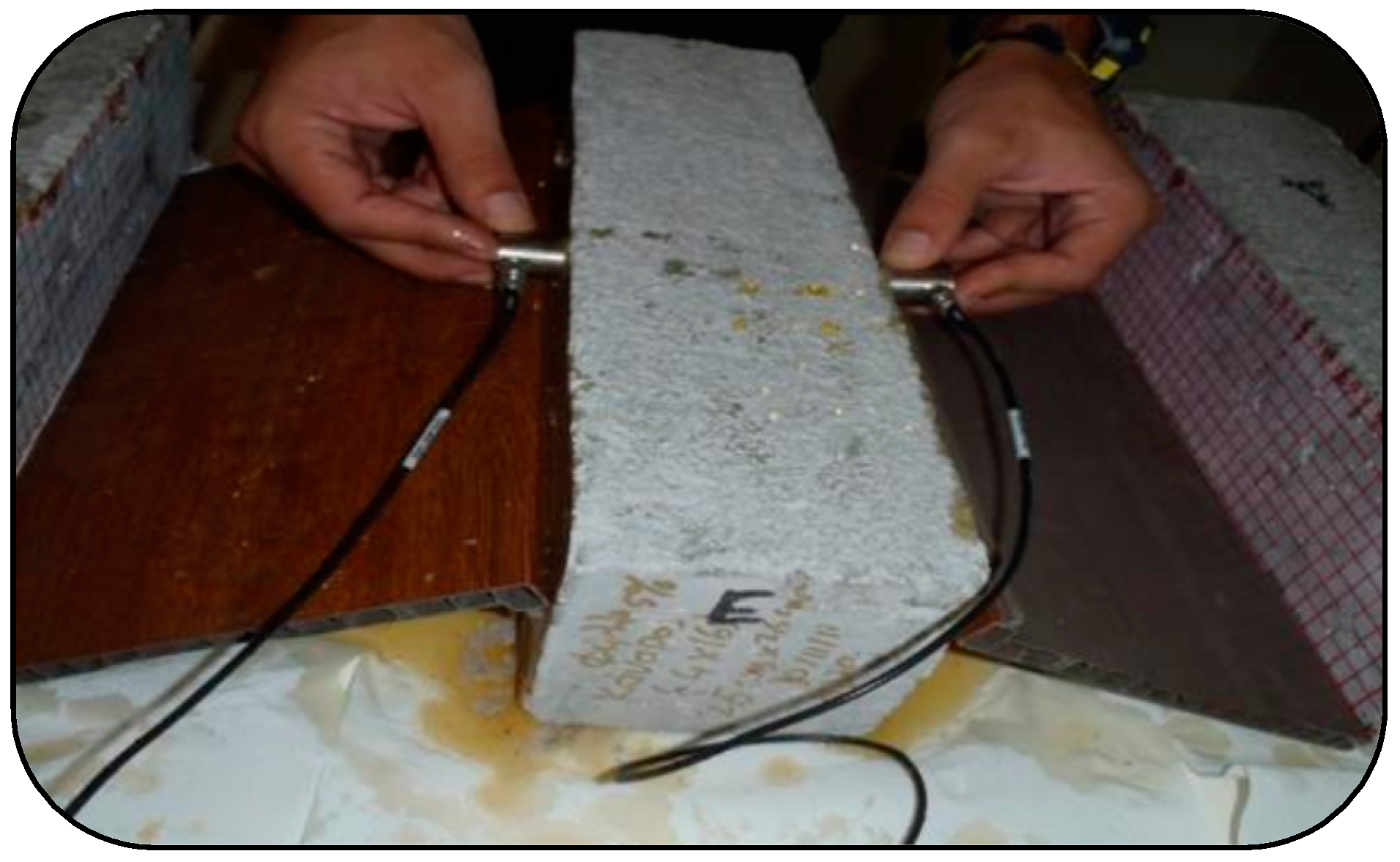
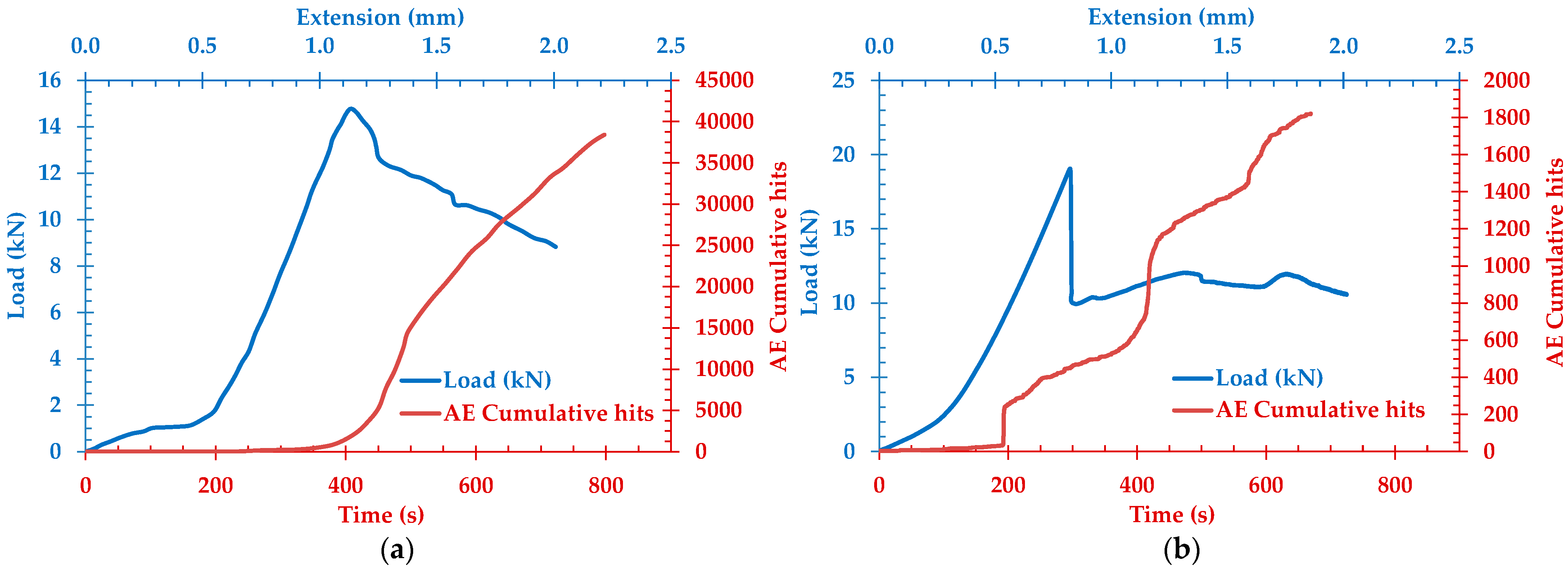
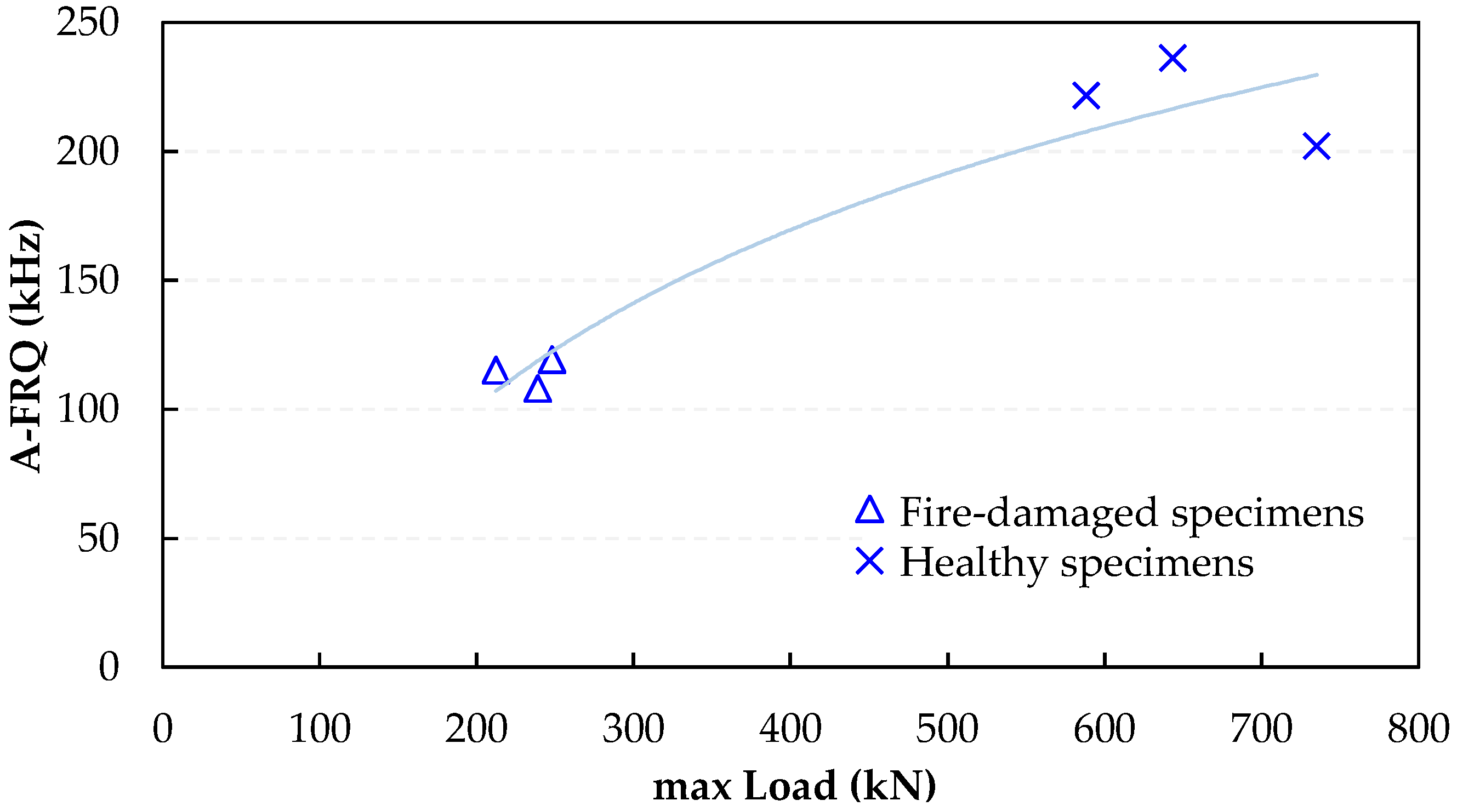
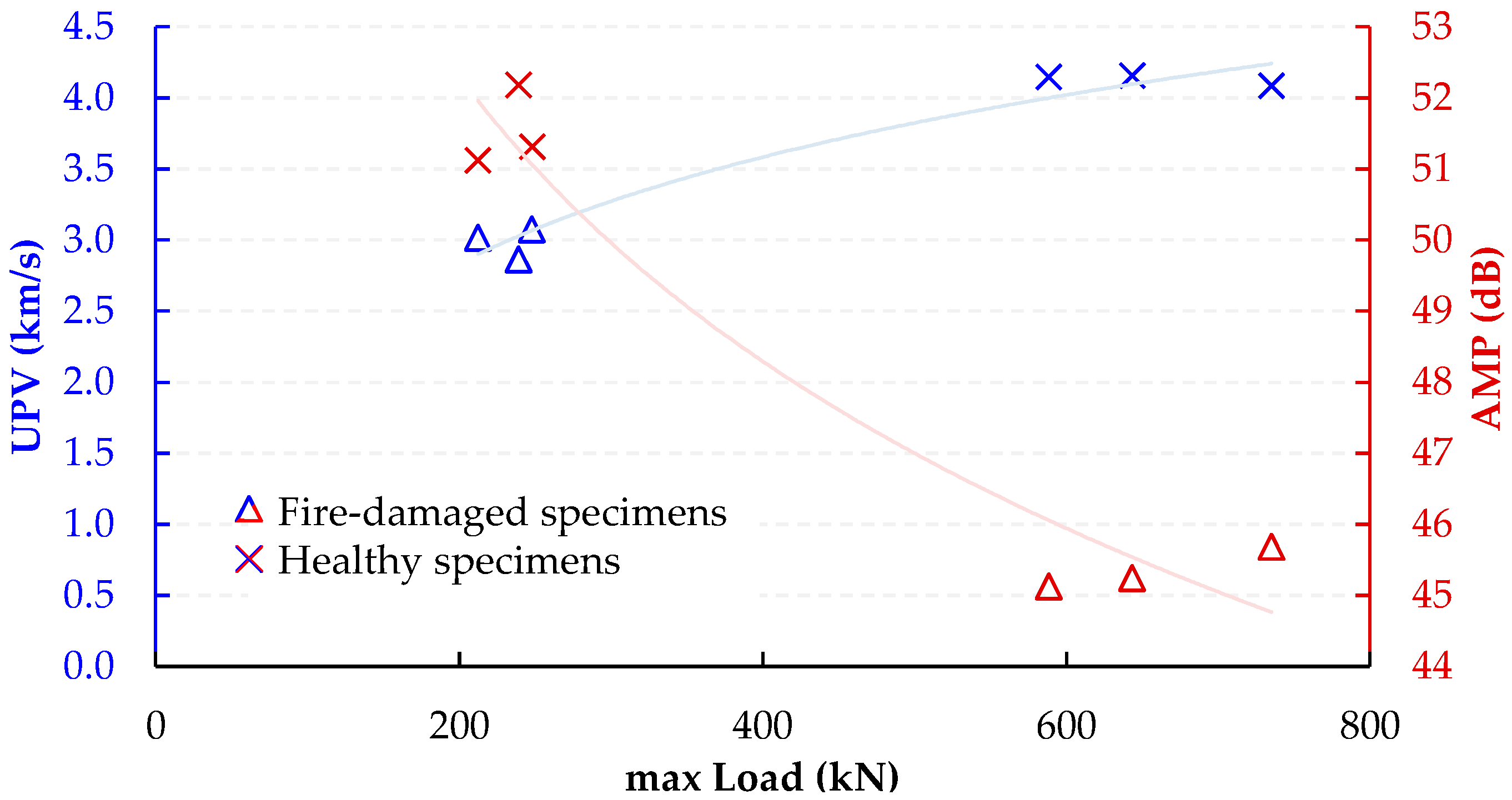

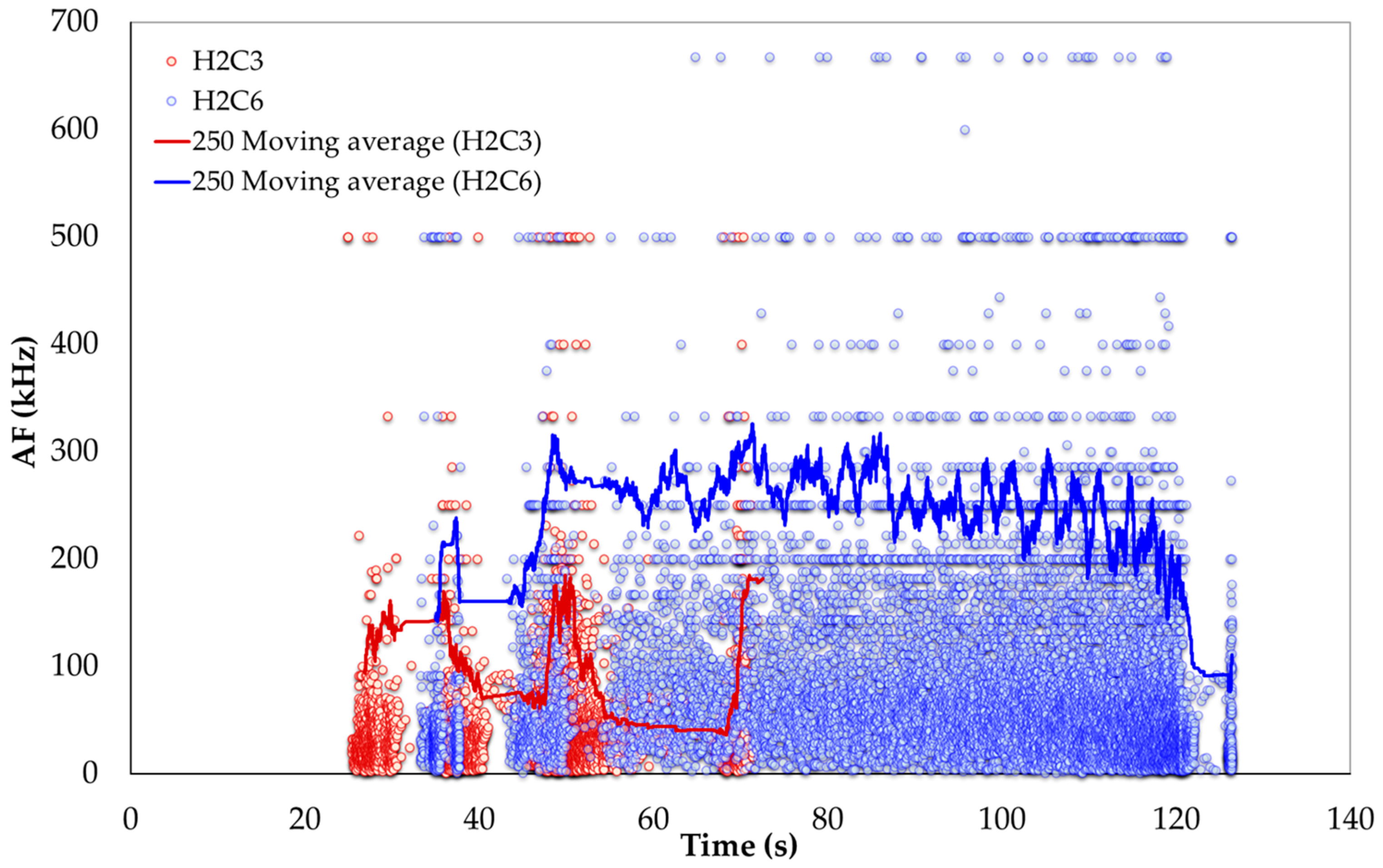
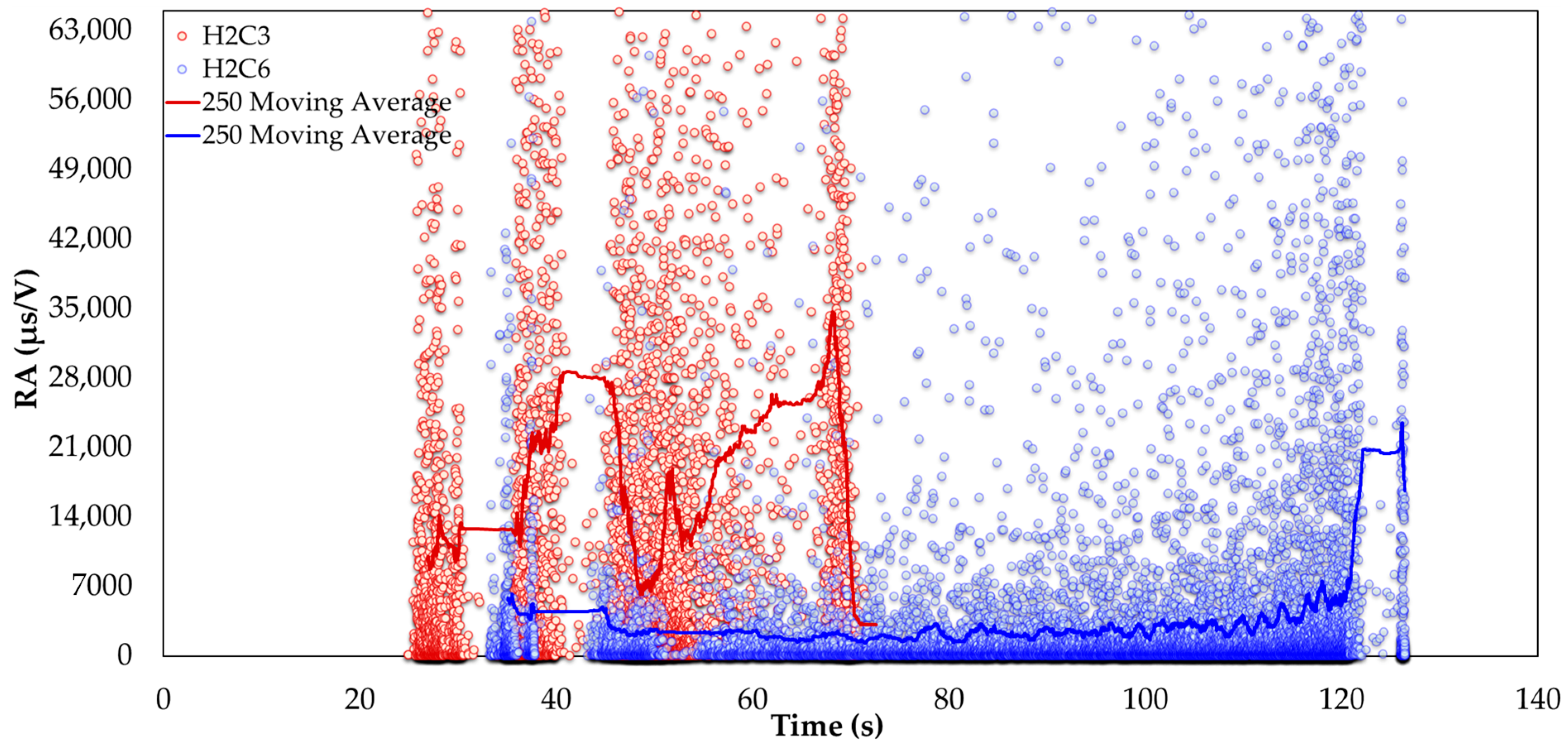
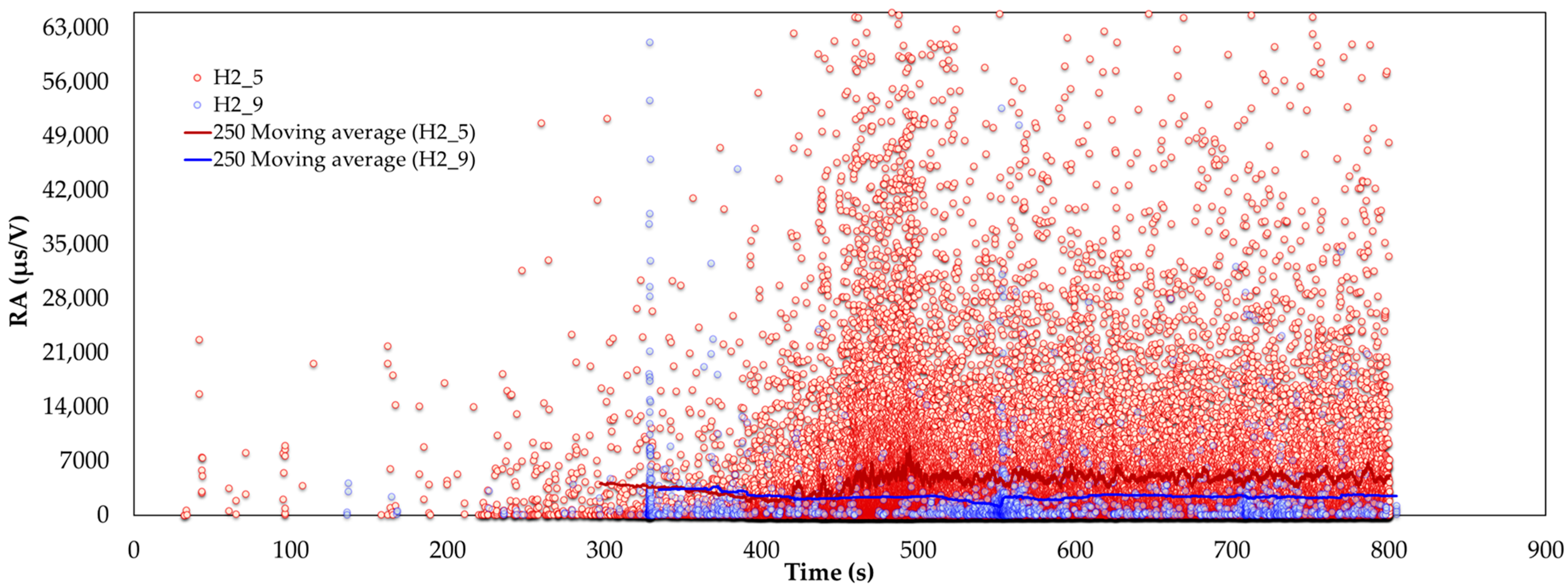
| Cement (Type II 42.5 N) | Water | Crushed Sand | Fine Gravel | Retarder–Plasticizer (CHEM I) | Retarder–Plasticizer (CHEM II) |
|---|---|---|---|---|---|
| (kg/m3) | (kg/m3) | (kg/m3) | (kg/m3) | (kg/m3) | (kg/m3) |
| 350 | 245 | 1161 | 404 | 1.54 | 1.96 |
| Average Max Load (kN) | UPV (m/s) | |
|---|---|---|
| Fire-Damaged Bending Specimens | 15.45 | 3233.29 |
| Healthy Bending Specimens | 24.70 | 4274.10 |
| Fire-Damaged Compression Specimens | 233.20 | 2982.07 |
| Healthy Compression Specimens | 655.72 | 4127.07 |
| Specimen Name | Hits | Sum ENER (10−14 V2s) | ENER (10−14 V2s) | DURATION (μs) | AMP (dB) | A-FRQ (kHz) | RA (μs/V) |
|---|---|---|---|---|---|---|---|
| Fired-Damaged Bending Specimens | |||||||
| H2_1 | 38,339.00 | 802,196.00 | 20.92 | 884.35 | 47.51 | 152.20 | 4726.96 |
| H2_2 | 28,362.00 | 708,930.00 | 24.99 | 865.51 | 47.79 | 164.46 | 4117.19 |
| H2_3 | 28,110.00 | 460,369.00 | 16.38 | 706.18 | 47.75 | 158.75 | 3618.20 |
| H2_4 | 43,890.00 | 920,812.00 | 20.98 | 796.78 | 48.08 | 152.13 | 3985.14 |
| H2_5 | 23,365.00 | 371,693.00 | 15.91 | 698.94 | 47.31 | 180.90 | 3414.55 |
| H2_6 | 47,296.00 | 821,251.00 | 17.36 | 718.71 | 47.72 | 151.15 | 3955.37 |
| Average | 34,893.67 | 680,875.17 | 19.42 | 778.41 | 47.69 | 159.93 | 3969.57 |
| Healthy Bending Specimens | |||||||
| H2_7 | 272.00 | 3393.00 | 12.43 | 342.71 | 46.41 | 216.01 | 1248.72 |
| H2_8 | 3463.00 | 30,357.00 | 8.76 | 313.54 | 46.02 | 255.16 | 1146.57 |
| H2_9 | 7852.00 | 43,661.00 | 5.56 | 281.97 | 45.78 | 251.10 | 1640.35 |
| Average | 3862.33 | 25,803.67 | 8.92 | 312.74 | 46.07 | 240.76 | 1345.21 |
| Specimen Name | Hits | Sum ENER (10−14 V2s) | ENER (10−14 V2s) | DURATION (μs) | AMP (dB) | A-FRQ (kHz) | RA (μs/V) |
|---|---|---|---|---|---|---|---|
| Fired-Damaged CompressionSpecimens | |||||||
| H2_c1 | 3641.00 | 2,384,061.00 | 654.60 | 17,210.64 | 51.31 | 119.26 | 14,388.27 |
| H2_c2 | 4305.00 | 2,000,598.00 | 464.61 | 12,167.51 | 51.12 | 115.06 | 12,171.61 |
| H2_c3 | 5934.00 | 1,501,131.00 | 252.93 | 9513.33 | 52.18 | 107.97 | 14,883.35 |
| Average | 4626.67 | 1,961,930.00 | 457.38 | 12,963.83 | 51.54 | 114.09 | 13,814.41 |
| Healthy CompressionSpecimens | |||||||
| H2_c4 | 21,845.00 | 421,591.00 | 19.30 | 970.37 | 45.68 | 202.09 | 5878.04 |
| H2_c5 | 13,137.00 | 372,592.00 | 28.36 | 1481.19 | 45.12 | 221.61 | 7293.30 |
| H2_c6 | 13,777.00 | 355,977.00 | 25.84 | 1010.75 | 45.24 | 236.18 | 3686.38 |
| Average | 16,253.00 | 383,386.67 | 24.50 | 1154.10 | 45.35 | 219.96 | 5619.24 |
Disclaimer/Publisher’s Note: The statements, opinions and data contained in all publications are solely those of the individual author(s) and contributor(s) and not of MDPI and/or the editor(s). MDPI and/or the editor(s) disclaim responsibility for any injury to people or property resulting from any ideas, methods, instructions or products referred to in the content. |
© 2024 by the authors. Licensee MDPI, Basel, Switzerland. This article is an open access article distributed under the terms and conditions of the Creative Commons Attribution (CC BY) license (https://creativecommons.org/licenses/by/4.0/).
Share and Cite
Mpalaskas, A.C.; Kytinou, V.K.; Zapris, A.G.; Matikas, T.E. Optimizing Building Rehabilitation through Nondestructive Evaluation of Fire-Damaged Steel-Fiber-Reinforced Concrete. Sensors 2024, 24, 5668. https://doi.org/10.3390/s24175668
Mpalaskas AC, Kytinou VK, Zapris AG, Matikas TE. Optimizing Building Rehabilitation through Nondestructive Evaluation of Fire-Damaged Steel-Fiber-Reinforced Concrete. Sensors. 2024; 24(17):5668. https://doi.org/10.3390/s24175668
Chicago/Turabian StyleMpalaskas, Anastasios C., Violetta K. Kytinou, Adamantis G. Zapris, and Theodore E. Matikas. 2024. "Optimizing Building Rehabilitation through Nondestructive Evaluation of Fire-Damaged Steel-Fiber-Reinforced Concrete" Sensors 24, no. 17: 5668. https://doi.org/10.3390/s24175668








